Abstract
In this study, we investigate the potential of two-photon lithography (2PL) as a solution to the challenges encountered in conventional membrane fabrication techniques, aiming to fabricate tailor-made membranes with high-resolution submicron pore structures suitable for advanced applications. This approach led to the development of fabrication techniques and printed membranes that can be adapted to various lab-on-a-chip (LOC) devices. Membranes were fabricated with pore diameters as small as 0.57 µm and porosities of 4.5%, as well as with larger pores of approximately 3.73 µm in diameter and very high porosities that reached up to 60%. Direct 3D printing of membranes offers a pathway for fabricating structures tailored to specific applications in microfluidics, enabling more efficient separation processes at miniature scales. This research represents a significant step towards bridging the gap between membrane technology and microfluidics, promising enhanced capabilities for a wide array of applications in biotechnology, chemical analysis, and beyond.
1. Introduction
Membranes act as selective barriers, regulating fluid flow based on specific criteria, such as concentration gradients or pressure differences [1]. Membranes are employed across many industries because they offer efficient, passive separation methods without additional energy being required to induce separation [2]. Conventional membrane fabrication techniques, such as phase inversion, track-etching, and electrospinning, have been widely utilized for the production of membranes across various applications [3]. Phase inversion techniques rely on the precipitation of a polymer solution to form a membrane structure. This method involves dissolving a polymer in a solvent, and then, immersing the solution into a non-solvent bath, causing the polymer to precipitate and form a porous structure. This technique is favored for its simplicity and versatility but can result in membranes with irregular pore sizes and distributions [4]. Track-etching methods involve the chemical etching of polymer films to create uniform, cylindrical pores. This method offers precise control over pore size and density but is limited by the need for specialized equipment and materials [5]. Additionally, electrospinning uses electric forces to draw polymer fibers from a liquid solution or melt, creating ultrafine fibers that are randomly deposited to form membranes. These electro-spun membranes are characterized by their high surface area and fine fiber diameters, but achieving consistent fiber morphology and membrane thickness can be challenging [6]. While these methods have proven effective in many cases, they often face limitations for specific applications due to limited material options, as well as lack of uniformity and control in the fabricated membrane structure [7]. In addition these conventionally fabricated membranes are difficult to incorporate into microfluidic devices [8], requiring multistep and multilayer fabrication processes for microfluidic integration [9,10].
Techniques that are used in microfluidic applications, like polydimethylsiloxane (PDMS) molding and many lithography methods, provide significant control over membrane structure but cannot achieve the micron- and submicron-scale resolution seen in conventionally fabricated membranes [11]. The capability of the technology falls short in achieving the resolution required for microfiltration and ultrafiltration as membrane pore sizes for these types of filtration need resolutions ranging from 0.001–10 µm [12].
The emergence of 3D printing offers a promising solution to these challenges, offering the potential for unprecedented customization and fine-scale fabrication [13]. However, the application of 3D printing in producing membranes that are highly tailorable and achieve submicron pore sizes remains limited [14,15]. Many 3D-printed membranes, such as those created using fused deposition modeling (FDM) [16], rely on the porosity of the printed material, resulting in membranes that have the same drawbacks as those fabricated using conventional methods [17,18]. Whereas 3D-printed membranes where the membrane structure is directly controlled through stereolithography (SLA) or digital light processing (DLP) techniques suffer from resolution limitations [19,20]. Furthermore, these light-based printing methods are often restricted by the available material options, although advancements in material are occurring rapidly [21]. This inability to achieve precise control and resolution presents challenges, as both pore size and membrane structure are critical factors in the utilization of membrane technology [22,23].
Unlike other printing methods, two-photon lithography (2PL) can achieve sub-100 nanometer resolution by utilizing nonlinear absorption of photons to induce polymerization in a precise localized volume [24]. Exploring the fabrication parameters of 2PL presents a promising avenue for generating controlled porous structures at submicron resolution. By adjusting the slicing and laser parameters during printing, researchers can exert precise control over the laser path, which in turn influences pore size, shape, and distribution within the membrane structure. This level of control offers the potential to tailor membranes and optimize their performance for specific applications. Moreover, ongoing advancements in 2PL technology and printable materials are paving the way for even finer control over membrane properties.
This research builds upon these advancements in additive manufacturing to introduce a novel approach that harnesses the capabilities of 2PL 3D printing to fabricate intricately designed membranes. By utilizing the high-resolution capabilities of 2PL for fabrication of membranes with submicron pore structures, this method aims to overcome the limitations of traditional fabrication methods and unlock new possibilities for membrane fabrication. Enabling the production of high-resolution and highly tailorable membranes makes a substantial contribution towards bridging the existing gap between membrane technology and microfluidic applications. The implications for more efficient separation processes at a miniature scale are profound, offering new avenues for innovation in areas ranging from chemical analysis to biomedical diagnostics.
2. Materials and Methods
2.1. Membrane Material and Fabrication Method
A wide range of membranes were fabricated using a 2PL 3D printer (Photonic Professional GT System, Nanoscribe GmbH, Karlsruhe, Germany) using OrmoComp® (Micro Resist Technology GmbH, Berlin, Germany) photoresist. The membranes were designed using the Describe software, which is part of the 3D printer’s suite. Describe allows for precise control over the slicing of solid bodies into meshes, adjusting parameters such as the pitch between hatch lines, the hatching angle, and the slicing height of each layer. Figure 1 demonstrates the hatching pitch and the effect of different hatching angles. By manipulating these slicing parameters, membranes can be fabricated with highly tailored porous structures. For this work, the standard 25× lens of the Nanoscribe 2PL printer was chosen to provide a balance of high resolution and short printing time. It is important to note that the shape of the voxel in a 2PL printer is an ovoid, where the height is significantly larger than the width [25]. A fixed slicing layer height of 0.9 µm was chosen since it allows each printing layer to seamlessly merge into the next, ensuring consistent connection between each sliced layer along the laser path.

Figure 1.
Depictions of sliced structures demonstrating (a) physical definitions of hatching pitch and hatching angle, along with structures showing hatching angles of (b) 45° and (c) 30°.
2.2. 3D Printing Parameter Sweeps for Optimizing Membrane Fabrication
The 3D printing laser parameters, including focal spot size, power, and exposure time, were utilized to control the voxel size—the minimum polymerized unit—thus dictating the resolution and features of the printed membrane structures. The focal spot size can be adjusted by changing the lens used for 2PL printing, with higher-magnification lenses resulting in smaller voxel sizes and finer fabricated features. Higher laser power and longer exposure times result in larger voxel sizes, delivering more energy to polymerize a greater material volume. Conversely, lower laser power and shorter exposure times produce smaller voxel sizes, enabling finer details and higher resolution in printed structures. Fine-tuning these laser parameters is crucial for precise control over resolution and quality in 2PL-printed objects.
To customize membrane dimensions based on slicing and laser parameters, the Describe slicing method was utilized to fabricate membranes within support structures, referred to as tables, shown in Figure 2. These tables were designed to mimic the type of support that the membranes would have within microchannels by elevating the membranes 50 µm from the base, allowing fluid to pass underneath. Additionally, the thickness of the tabletop surrounding the membranes was designed to be 15 µm, matching the thickest membrane to be tested. The tables offer a 75 × 75 µm area for the membrane, as well as a 75 × 50 µm area in the table design for testing if structures may require more dense support for certain membrane types to have stability.
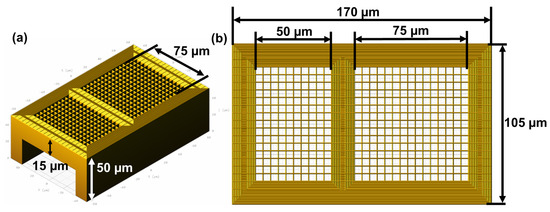
Figure 2.
Visualization of the table structure for the printing parameter sweep experiment, featuring (a) isometric and (b) top-down views, with key dimensions labeled. All borders of the top of the table structure are 15 µm thick.
Initially, membranes and their supporting tables were fabricated using hatching angles of 90°, 45°, and 30° and slicing pitches of 2, 3, 4, and 5 µm at 100% laser power. The membranes were printed with designed thicknesses of 5, 10, and 15 µm at scan speeds ranging from 20 to 95 mm/s, with the speed range varied depending on the sample. This is because membranes with smaller designed pitches (2 and 3 µm) require faster fabrication speeds, while those with larger pitches necessitate slower speeds to optimize pore size. Figure 3 provides a visualization of the printing parameters used for investigating the effects of these parameters on the fabricated pore sizes and membrane thickness. Additional fabrication parameter sweeps were also conducted with a 2 µm pitch while keeping all other parameters the same but adjusting the laser power to 95%, 90%, 85%, and 80%, respectively, aiming at achieving the smallest pore size possible.
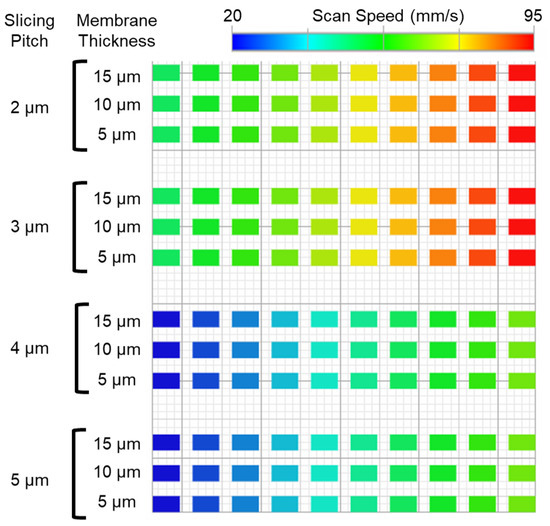
Figure 3.
Visualization of the laser and slicing parameters used in printing parameter sweeps.
2.3. Membrane Characterization
2.3.1. Imaging
The printed table structures were imaged using a scanning electron microscope (SEM), (Vega 3, TESCAN Group, a.s., Brno, Czech Republic). The imaging process involved capturing top-down views to measure pore area, followed by careful bisection of the printed tables using a razor blade for side-view SEM imaging.
2.3.2. Membrane Thickness
The software ImageJ (Version 1.52, Wayne Rasband, NIH, Bethesda, MD, USA) was employed to determine membrane thickness from the images of the bisected membranes of the 90° printed arrays in order to compare between designed and fabricated structures. A few tables of the 45° and 30° structures were also bisected for imaging in order to check that this behavior was consistent. This comparative analysis aims to provide insights into any disparities between the designed and printed membrane thicknesses.
2.3.3. Membrane Image Analysis
A MATLAB (Version R2019b, Cleve Moler, Mathworks, Portola Valley, CA, USA) script was developed to analyze SEM images and characterize membranes. The process applied to the images is outlined in Figure 4. Firstly, each image is imported into the MATLAB script and cropped to a square shape to exclude the SEM label, as depicted in Figure 4a. Subsequently, a global thresholding technique is applied to binarize the image, where white represents pore areas and black represents the solid material. This binarized image is depicted in Figure 4b. To delineate individual pores, the MATLAB function ‘bwboundaries’ is employed. This function identifies the boundaries between white and black pixels. These boundaries are outlined in black in Figure 4c. Utilizing the ‘bwboundaries’ function enables the characterization of each pore by its area, perimeter, centroid point, and boundary points. Additionally, the total number of areas found using ‘bwboundaries’ is recorded from the function.
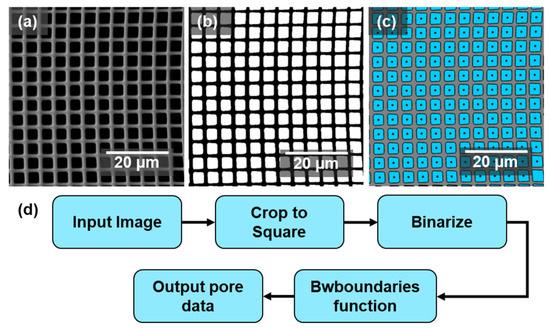
Figure 4.
Visualization of the MATLAB image processing script process: (a) depicts the input SEM image for a membrane fabricated with 5 µm hatching pitch, 15 µm thickness at 65 mm/s speed, cropped to square; (b) is the image after undergoing the thresholding process; (c) shows the final areas defined by the ‘bwboundaries’ function, outlined in black and highlighted in blue. Additionally, centroids of each pore are marked with black points, excluding those overlapping with the edge that are omitted from pore analysis, and (d) shows a flow chart detailing the MATLAB image processing program.
2.3.4. Membrane Porosity
The morphology of each membrane can easily be characterized using calculations based on all of the output values of the ‘bwboundaries’ function. The porosity of the membrane, P, is quantified by calculation using Equation (1), which takes the ratio of the total pore area to the total image area and determines the percentage of the membrane that is open area that fluid can pass through.
where is the area of each pore in the image and is the area of the total image.
2.3.5. Pore Size
Accurate pore size analysis requires the exclusion of any pores touching the image edges to avoid errors from incomplete data. Figure 4c marks the centroids of pores included in the following calculations using a black dot, with edge-intersecting pores left unmarked. With this adjustment, hydraulic diameter, , is used to quantify pore size and the calculation for this diameter is shown in Equation (2).
where A and P are the area and perimeter of each pore, respectively, determined via the ‘bwboundaries’ function. The hydraulic diameter is found for each pore in the image, and then, the average and standard deviation of all of the pores can be found to characterize the pore size distribution.
2.3.6. Pore Distribution
The radius of gyration, , was used to understand the distribution of pores across the surface of the membrane. The radius of gyration of a body is a metric used to characterize the distribution of an object’s mass around an axis. The calculation of the radius of gyration is the root mean square distance of all of an object’s parts from its center of mass or a given axis. In the context of the membrane, the radius of gyration determines the spread of all of the pores around the average pore position, as shown in Equation (3).
where is the x component of the centroid of each pore, is the average of every x component of the centroids of all the pores across one membrane, is the y component of the centroid of each pore, is the average of every y component of the centroids of all pores across one membrane, and N is the total number of pores used for calculation or the number of boundaries found minus the excluded sets that touch the edges of the image. The radius of gyration calculated for each membrane can then be normalized by half of the side length of the SEM image, as shown in Equation (4). This normalized radius of gyration, , better characterizes how the pore distribution fits within each image by considering how far the pores reach out relative to the center.
where is the side length of the image.
The methodology used for calculating the radius of gyration can be influenced by defects, including overexposure and underexposure during the printing process, which can significantly alter the pore distribution. For example, pore filling towards the center of the membrane leads to an increase in the normalized radius of gyration, while pore closure at the edges leads to a decrease. To ensure accuracy, the best normalized radius of gyration should be determined by comparing it to membranes known to be ideal. Other membranes should remain within a certain range of this ideal to be considered acceptable. Additionally, because the radius of gyration is calculated around the average location of all the pores, it is also beneficial to determine the skew of this average point away from the center of the image. The equation for the skew, S, of this point off center, shown in Equation (5), is found by deriving from the Pythagorean theorem based on the point locations of the average centroid and the center of the image.
where is the average of every x component of the centroids of all the pores across one membrane, is the x component of the center point of the image, is the average of every y component of the centroids of all pores across one membrane, and is the y component of the center point of the image. These methods collectively provide a comprehensive characterization of the membrane’s structural properties, which is essential for evaluating its suitability for specific applications.
3. Results
3.1. Overview of the Printed Membrane Tables
The successful incorporation of membranes into the printed tables is demonstrated in Figure 5, which presents SEM images of 3 × 3 sections of the characterization arrays. These arrays were printed with membranes fabricated using 4 µm hatching pitches at varying hatching angles of 90°, 45°, and 30°. The SEM images reveal the structural integrity and uniformity of the printed membranes, confirming their successful integration into the tables.

Figure 5.
SEM images of 3 × 3 sections of the characterization arrays printed with membranes fabricated with 4 µm hatching pitches and hatching angles of (a) 90°, (b) 45°, and (c) 30°.
The total area of the printed structures was consistent across the different hatching angles, ensuring uniformity for characterization. Each 3 × 3 section, as shown in the SEM images, maintains a consistent quality of the printed membranes, indicating a high degree of reproducibility in the printing process.
3.2. Membrane Thickness
Membrane thickness is a crucial parameter that directly impacts diffusion across a membrane. The bar chart in Figure 6 depicts the measured thicknesses of all 90° hatching angle membrane types with thicknesses of 5, 10, and 15 µm, as well as the disparity between the designed and measured thicknesses. This visualization offers a clear representation of the observed differences in membrane thickness across various designs. The analysis revealed a consistent trend across all printed membrane types: the actual membrane thickness consistently exceeded the designed thickness by around 2 µm, this value corresponds to the estimated voxel height of the 25× objective lens with the Nanoscribe printer.
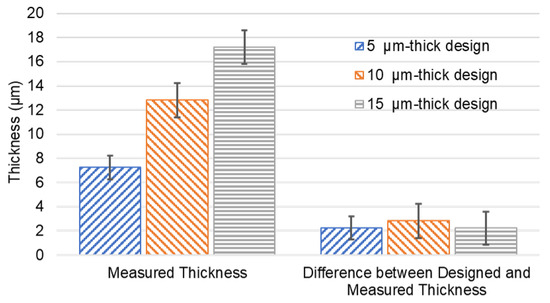
Figure 6.
Measured membrane thickness and discrepancy from designed thickness.
3.3. Membrane Tailorability
Using the slicing method and printing parameters outlined in the Methods section, a variety of pore structures were fabricated. Figure 7 showcases membranes with a hatching angle of 90° and pitches of 2, 3, 4, and 5 µm, respectively. Additionally, it includes 5 µm pitch membranes with hatching angles of 45° and 30°. All membranes were printed at 100% power and 15 µm designed thicknesses. The 4 and 5 µm slicing pitch membranes shown were printed with 65 mm/s speed, and the 2 and 3 µm slicing pitch membranes shown were printed with 95 mm/s scanning speeds. These images offer a clear visual representation of the variety of pore structures observed.
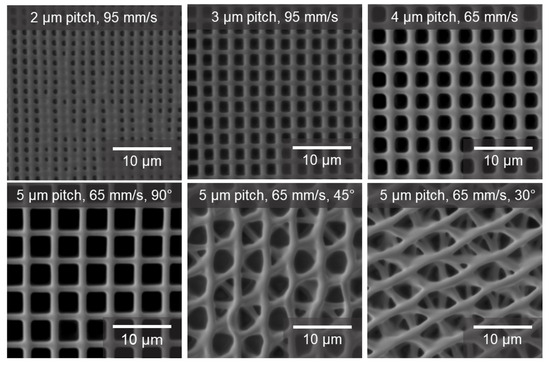
Figure 7.
Pore structures of printed membranes at different hatching angles and pitches. These samples were fabricated with designed thicknesses of 15 µm and printed at 100% power.
3.4. Effects of Hatching Pitch and Angle on Pore Count and Diameter
The parameters used for slicing significantly influence the geometry of membranes. Theoretically, decreasing the hatching pitch should increase the number of pores achievable for each membrane, and so should decrease the hatching angle. Figure 8 illustrates the maximum pore counts identified for each sample type to investigate these predictions. It can be seen that decreasing the hatching pitch did increase the number of pores. In addition, for larger hatching pitches of 4 and 5 µm, there is a trend where decreasing the hatching angle increased the number of pores, in line with the theoretical expectation. However, this trend is reversed with the 2 and 3 µm pitch data. Specifically, the 3 µm pitch samples exhibit slightly reduced maximum pore counts when the hatching angle is decreased, while the 2 µm pitch samples display a more pronounced decrease.
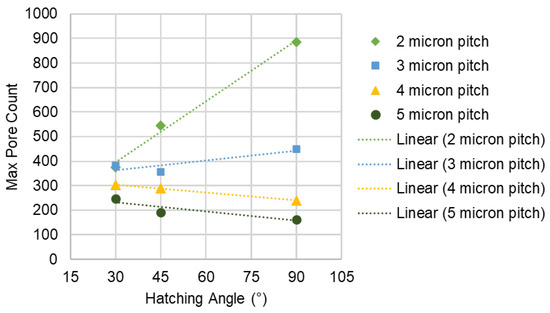
Figure 8.
Plot of the maximum number of pores counted per sample type based on hatching pitch and angle.
Moreover, by adjusting both the hatching pitch and angle, the number and size of pores in a given area can be controlled. Figure 9 presents contour plots depicting the average hydraulic diameters of membranes fabricated with various slicing parameters at 100% power across membrane thicknesses and printing speeds. The plots in Figure 9 illustrate that pore size is influenced by both hatching angle and pitch. With other printing parameters held constant, pore size varies with the hatching pitch for the same hatching angle. For example, the largest pore size observed, produced using a 5 µm hatching pitch, a 90° hatching angle, a 10 µm designed thickness, and a speed of 65 mm/s, had a 3.73 µm hydraulic diameter (Figure 9d). A 4 µm pitch resulted in 2.75 µm pores (Figure 9c), a 3 µm pitch produced 1.89 µm pores (Figure 9b), and a 2 µm pitch yielded submicron pores at 0.68 µm (Figure 9a). Similarly, changing the hatching angle while keeping a 4 µm pitch and all other parameters the same resulted in pore sizes of 2.75 µm at 90° (Figure 9c), 1.79 µm at 45° (Figure 9g), and 1.42 µm at 30° (Figure 9k).
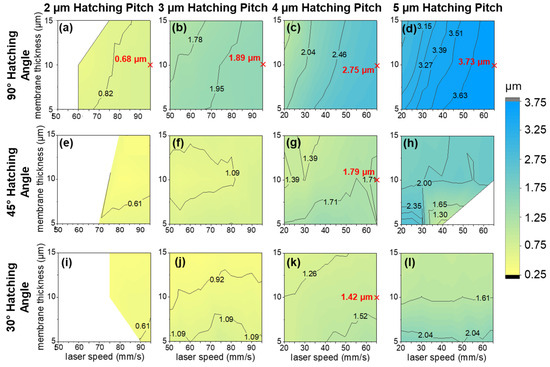
Figure 9.
Contour plots of hydraulic diameters as a function of membrane thickness and laser speed for membranes fabricated with 100% power at (a–d) 90°, (e–h) 45°, and (i–l) 30° hatching angles, with hatching pitches of (a,e,i) 2 µm, (b,f,j) 3 µm, (c,g,k) 4 µm, and (d,h,l) 5 µm. Key membrane parameters referenced in the text are highlighted with a red cross and labeled with the corresponding hydraulic diameter.
White spaces in the contour plots indicate failed prints. Figure 10 highlights the modes of failure by comparing two membranes from the dataset made with a 45° hatching angle with a 5 µm designed thickness. The sample shown in Figure 10a, fabricated with a 2 µm pitch at 70 mm/s, demonstrates that increased exposure dosage, due to slower print speeds or higher laser power, results in more material polymerization along the path line, reducing the porous areas within the membranes. In extreme cases, overexposure can lead to total solidification of the membrane material. Conversely, the sample shown in Figure 10b, fabricated with a 5 µm pitch and a laser speed of 35 mm/s, illustrates the effect of decreased energy dosage. Insufficient crosslinking during printing results in softer material that deforms easily, causing the pore walls to converge during development. When the membrane is flood-exposed, these walls crosslink together due to their proximity, altering the membrane structure. This extreme deformation in the fluid bath can lead to the membrane tearing away from the support table. When membranes exhibit these effects of under or overexposure that result in near-total solidification or tearing away from the support, they are excluded from the dataset.
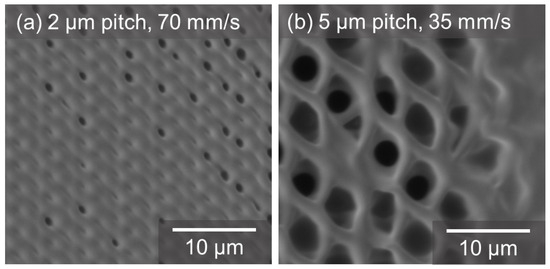
Figure 10.
Membranes with 5 µm designed thickness and 45° hatching angle printed at 100% power used to highlight the effects on membrane geometry from (a) overexposure (2 µm hatching pitch and a print speed of 70 mm/s) and (b) underexposure (5 µm hatching pitch and a print speed of 35 mm/s).
3.5. Influence of Laser Exposure Time on Pore size and Pore Size Distribution
Figure 11 presents line plots of the average pore hydraulic diameters, along with standard deviations, across various hatching angles and thickness for the 5 and 3 µm hatching pitch datasets. This representation offers clearer insights into how laser speed and membrane thickness affect membrane pore hydraulic diameter. The inclusion of standard deviation in the plots enables examination of the pore size distribution among different hatching angles. In both hatching pitches, membranes printed at 90° exhibit larger pore sizes and smaller standard deviations compared to those at 45° and 30° angles, indicating that reduced hatching angles result in smaller yet more varied pore shapes, as can been seen in Figure 7.
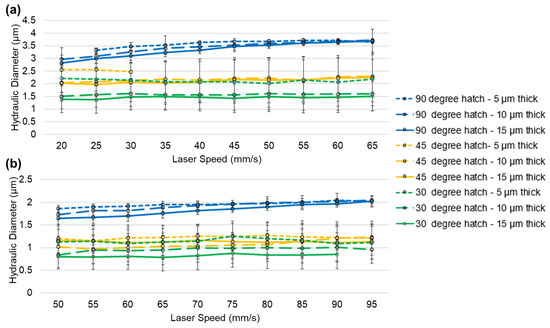
Figure 11.
Line plots of the hydraulic diameter of membranes fabricated at different laser speeds for samples with (a) 5 µm hatching pitches and (b) 3 µm hatching pitches. These results are shown for samples fabricated at different hatching angles (90°, 45°, and 30°) and varied designed membrane thicknesses (5 µm, 10 µm, and 15 µm). Standard deviation error bars are included to illustrate the variability in pore sizes across different angles and pitches.
Figure 11 shows that the decrease in pore size with the decrease in laser speed is more obvious for membranes printed at a 90° hatching angle. In contrast, the decrease in pore size with membrane thickness is more prevalent for membranes printed at lower hatching angles. For membranes fabricated with 45° and 30° hatching angles, this effect is apparent, as demonstrated by the 5 µm hatching pitch and the 5 µm thick membranes having a hydraulic diameter approximately 0.5 µm larger than their thicker counterparts. Yet, for these 45° and 30° hatching angle membranes, the effect of speed on the hydraulic diameter is reduced.
In addition to the reduced pore size, the membranes fabricated at 45° and 30° hatching angles exhibit less structural stability compared to their 90° angle counterparts. This is particularly evident in the 45°, 5 µm thick sample, where few data points are plotted in Figure 11 due to structural instability causing membrane pore closure. The 45° and 30° hatching angles result in fewer overlapping layers compared to the 90° angle membranes due to hatch angle changes in each layer. This effect is pronounced in the 5 µm hatching pitch membranes. However, reducing the hatching pitch to 3 µm significantly enhances membrane stability.
The laser speed during printing and membrane thickness both influence the exposure time of each point along the laser path, impacting the printing process. Reducing the laser speed increases exposure time, which in turn increases exposure dosage at each point along the laser path, thus slightly reducing the size of pores fabricated in between the laser path by increasing the amount of polymerized material. Increasing thickness leads to more passes over overlapping areas covered by each vertical slice of the print. This increased number of passes increases the amount of exposure time, and therefore, increases the energy dosage imparted to each point on the laser path, thereby impacting pore size.
3.6. Membrane Porosity Analysis
Figure 12 illustrates the membrane porosity of the membranes by utilizing contour plots delineated by fabricated membrane thickness and laser printing speed for samples fabricated at 100% laser power for different hatching pitch and angles. Generally, porosity decreases with hatching pitch and hatching angle.
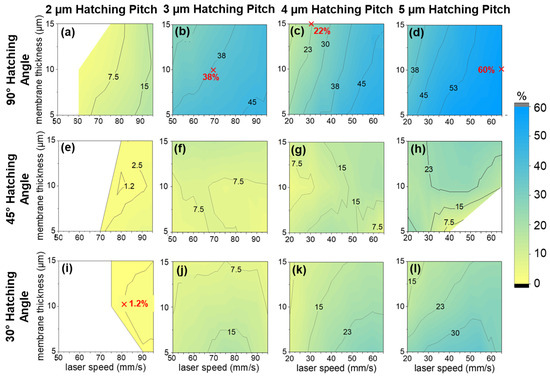
Figure 12.
Contour plots illustrating membrane porosity plotted over membrane thickness and laser speed for membranes fabricated with 100% power at (a–d) 90°, (e–h) 45°, and (i–l) 30° hatching angles, with hatching pitches of (a,e,i) 2 µm, (b,f,j) 3 µm, (c,g,k) 4 µm, and (d,h,l) 5 µm. Key membrane parameters for membranes shown in the figure are marked with a red cross and labeled with the corresponding porosity of that membrane.
This adjustment of laser parameters enables precise control of membrane properties that affect membrane selectivity and efficiency. An example of this is shown in Figure 13, where two membranes with identical average hydraulic pore diameters but differing porosities have been identified. Both of these are 90° hatching angle membranes, the 3 µm hatching pitch sample, made at 10 µm thick and 70 mm/s, and the 4 µm hatching pitch sample, fabricated at 15 µm thick and 30 mm/s print speeds, exhibit pore hydraulic diameters of approximately 1.9 µm. However, the former demonstrates a porosity of 38% (Figure 12b), while the latter has a porosity of only 22% (Figure 12c). This difference can be attributed to the relatively thinner voxel path line of the 3 µm hatching pitch membrane compared to the 4 µm pitch membrane, resulting in a membrane with comparable hydraulic diameter but notably higher porosity. Thus, while hatching pitch and angle are critical parameters in controlling membrane geometry, manipulation of all parameters is essential to fabricate the ideal membrane for any given application.
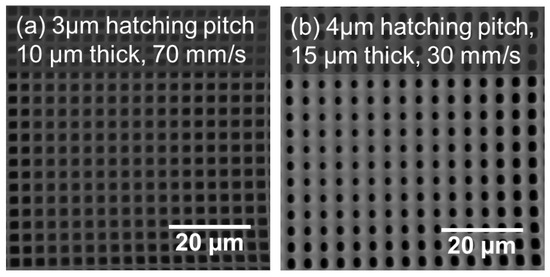
Figure 13.
SEM images of membranes fabricated at 100% power: (a) a 3 µm hatching pitch, a designed thickness of 10 µm, and a laser speed of 70 mm/s; and (b) a 4 µm hatching pitch, a designed thickness of 15 µm, and a laser scanning speed of 30 mm/s. Both print settings result in a pore hydraulic diameter of 1.9 µm. However, (a) results in a porosity of 38%, while (b) results in a porosity of 22%.
Not only is the porosity of membranes fabricated with this method highly tailorable, but there is also a wide range of porosity that can be achieved. The data in Figure 12 show a range of porosity values from as high as 60% (Figure 12d) to values as low as 1.2% (Figure 12i). Although, the low-end porosities from the 2 µm hatching pitch angles may actually be from membranes that are nearly totally sealed.
3.7. Membrane Quality Check Criterion
Three different metrics were utilized to determine the quality of the membrane: (1) the number of pores counted in each membrane, (2) the normalized radius of gyration, and (3) the skew of the average pore off the image center. The membranes fabricated with 3 to 5 µm hatching pitches and a 90° hatching angle consistently exhibited an average normalized radius of gyration that was approximately 86% of half the side length of the image. The largest skew was 3.2 µm. These values serve as metrics for comparison to the behavior of other membranes.
Figure 14 shows contour plots of these metrics for the 45° hatching angle and 2 µm hatching pitch membranes across various thicknesses, laser powers, and speeds, as well as a few SEM images of example membranes. Given that the 45° hatching angle is identified as the least structurally stable and the 2 µm hatching pitch offers the finest resolution and the greatest likelihood of sealing due to under and overexposure, an analysis of this dataset yields invaluable insights into the constraints inherent in the fabrication method.
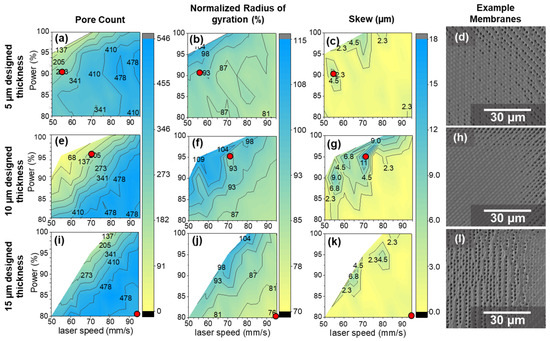
Figure 14.
Contour plots illustrating the (a,e,i) pore count, (b,f,j) normalized radius of gyration, and (c,g,k) skew for membranes fabricated with 2 µm hatching pitches and 45° hatching angles. The membranes are categorized by designed thickness: (a–c) 5 µm, with red dots noting the source of the membrane shown in (d); (e–g) 10 µm, with red dots noting the source of the membrane shown in (h); and (i–k) 15 µm, with red dots noting the source of the membrane shown in (l). Additionally, SEM images of example membranes from the dataset are provided: fabricated with (d) a thickness of 5 µm at 90% power and 55 mm/s speed, (h) a thickness of 10 µm at 95% power and 70 mm/s speed, and (l) a thickness of 15 µm fabricated at 80% power and 95 mm/s speed.
In regions where high-energy regimes are achieved with low-speed and high-power print settings, such as those observed in the upper left-hand quadrants of the contour plots in Figure 14e–g, observable changes include a reduction in pore count, an increase in the normalized radius of gyration, and a rise in skew. Occasionally, the normalized radius exceeds 100% when the radius of gyration is more than half the side length of the sample. When the center of the membrane is overexposed, leaving only pores around the outer edges, the radius of gyration is disproportionately large. This is due to the absence of internal pores to balance the calculation. This phenomenon is highlighted in Figure 14h, which shows a membrane printed with a thickness of 10 µm at 95% power and a speed of 70 mm/s (Figure 14e–g). This uneven pore closure results from the uneven distribution of laser intensity across the print field in two-photon laser printing. The skew varies due to the offset center of the print field relative to the imaged support area. Overexposure in these areas also leads to a significant reduction in pore count per sample.
Conversely, in the 15 µm thickness membrane datasets shown in Figure 14i–k, a low-energy regime can be observed in the lower right-hand quadrant of the contour plots. This low-energy regime occurs when printing with low power and high speeds. Despite minimal changes in pore count or skew, there is a drop in the normalized radius of gyration below 80% in this region. Figure 14l highlights the reason for this, showing an SEM image of a membrane fabricated with a thickness of 15 µm, 80% power, and 95 mm/s speed (Figure 14i–k). Lower energy around the print’s periphery leads to more significant material under-curing, increased deformation during development, and a subsequent reduction in the radius of gyration.
For membranes where effects from both under and overexposure are observable, there tends to be sealing from overexposure more on the left side of the membrane, while the closing up of pores from underdevelopment tends to be more on the right side. This can be seen in the SEM image of the sample membrane in Figure 14d, fabricated with a thickness of 5 µm at 90% power and 55 mm/s speed (Figure 14a–c). This pattern is due to the positioning of the field of view during printing. The analysis for these pores is performed on a 75 × 75 µm area of the support structure, which is positioned slightly off-center of the print to accommodate the 50 × 75 µm area of the support structure. Thus, towards the center of the print field, there is more overexposure because the laser delivers a higher energy dosage in this area than it does towards the periphery. For the optimal application of these membranes in the future, it would be better to print a smaller, more centered field of view within each support structure to achieve the most ideal pore distribution across the membrane surface.
Based on the observations of the samples with a 3 to 5 µm hatching pitch and a 90° hatching angle, it was determined that ideal membrane geometries should have skew values lower than 3.2 µm. Additionally, the radius of gyration should range from 80% to 90% of half of the side length of the image area. Given that smaller pore sizes are desirable, and based on the behaviors observed with the 2 µm hatching pitch and 45° hatching angle membranes, it was decided that membranes should have approximately 75% of the maximum pore count for their respective geometries to be considered acceptable. For the 45° hatching angle membranes highlighted in Figure 13, the highest pore count is 546. Therefore, 409 pores, which is approximately 75% of 546, was chosen as the pore count metric for these membranes.
3.8. Implementation of Quality Criterion on 2 µm Pitch Membranes
Utilizing the criteria discussed, the hydraulic diameters of the 2 µm hatching pitch membranes can be investigated to achieve the highest possible resolution with this fabrication method. Contour plots of the hydraulic diameters found for all 2 µm hatching pitch membranes that surpass these validation metrics are shown in Figure 15 along with SEM images of example membranes.
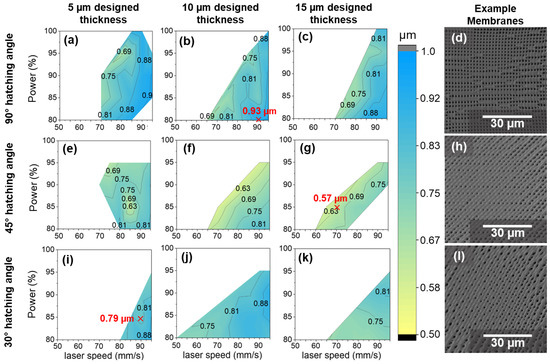
Figure 15.
Contour plots depicting the average pore hydraulic diameters across printing power and speed of membranes that passed the selection criteria. These membranes were fabricated with 2 µm hatching pitches and designed thicknesses of (a,e,i) 5 µm, (b,f,j) 10 µm, and (c,g,k) 15 µm, with hatching angles of (a–c) 90°, (e–g) 45°, and (i–k) 30°. SEM images of example membranes from the dataset are also shown that are fabricated with (d) a 90° hatching angle, 10 µm designed thickness, 80% power, and 90 mm/s speed; (h) a 45° hatching angle, 10 µm designed thickness, 85% power, and 70 mm/s speed; and (l) a 30° hatching angle, 5 µm designed thickness, 85% power, and 90 mm/s laser speed. The locations of the membranes in (d), (h), and (l) are marked with red crosses and labeled with their diameter values in the plots of (b), (g), and (i), respectively.
The membrane found to have the highest porosity is shown in Figure 15d. This sample was fabricated with a 90° hatching angle, 10 µm designed thickness, 80% power, and 90 mm/s speed. The sample has a porosity of 17.5% and a hydraulic diameter of 0.93 µm (Figure 15b). The membrane with the smallest pore hydraulic diameter found within the dataset is shown in Figure 15h and measures approximately 0.57 µm with a porosity of 4.5% (Figure 15g). This diameter is observed in a membrane fabricated with a 45° hatching angle, 15 µm thickness, 85% laser power, and 70 mm/s laser speed. The 30° hatching angle sample shown in Figure 15l with 5 µm designed thickness, fabricated at 85% power, and 90 mm/s laser speed was found to have an average pore hydraulic diameter of 0.79 µm and a porosity of 8.3% (Figure 15i).
These results for the 2 µm hatching pitch membranes are indicative of the resolution limitations of this fabrication method when using Ormocomp as a photoresist with the 25× lens on the Nanoscribe 2PL printer. Although, further tailoring the method using other materials or higher-resolution lenses may further improve the resolution limitation of the method, printing membranes in this way successfully enables the fabrication of highly customizable membranes with varied geometries that achieve porosities ranging from 60% to 4.5% and pore sizes from 3.73 µm to 0.57 µm in diameter. The membranes were characterized using an image processing script written in MATLAB, enabling the determination of metrics to describe the optimal membrane spatial distribution.
4. Discussion
The results of this study provide significant insights into the impact of various printing parameters on the characteristics of polymer membranes fabricated using 2PL. Firstly, the observed trend in the actual membrane thickness exceeding the designed thickness by approximately 2 µm underscores the importance of understanding the fabrication methods, as this variance corresponds to the estimated voxel height of the 25× objective lens with the Nanoscribe printer. The discrepancy between designed and measured thicknesses may have important implications for diffusion properties across the membrane and must be considered for the application of these structures.
Three-dimensional porous membranes with varied membrane geometries were successfully fabricated through the manipulation of slicing and printing parameters using 2PL printing. The ability to customize pore structures using different hatching angles and pitches demonstrates the versatility of the fabrication process. Membranes with finer pitches and lower hatching angles result in smaller pore sizes. This tailorability is crucial for applications requiring specific membrane properties, such as filtration efficiency and selectivity.
Furthermore, the impact of printing parameters such as laser power and printing speed on membrane geometry and structural stability highlights the complexity of membrane fabrication and the need for meticulous parameter optimization. Variations in laser power and printing speed exert significant influence on membrane properties, including porosity, pore size, and structural integrity. Slower laser speeds and increased membrane thickness lead to greater exposure times, which in turn result in smaller pore sizes due to increased material polymerization. This relationship was particularly evident for membranes printed at a 90° hatching angle. Membranes fabricated at lower hatching angles (45° and 30°) were found to be less structurally stable, particularly when printed with thicker layers and slower speeds. This instability likely results from fewer overlapping layers and reduced mechanical support within the membrane structure. Thus, optimizing laser parameters to balance exposure and stability is critical for achieving high-quality membranes.
The analysis of membrane porosity revealed a wide range of porosities, from 60% to as low as 4.5%. High-porosity membranes are desirable for applications requiring high permeability, while low-porosity membranes can be useful for more selective filtration processes. The study’s findings that lower hatching pitches generally lead to lower porosities align with the expectation that finer pitches create denser structures with fewer voids. The comparison of two membranes with identical pore diameters but different porosities further underscores the importance of hatching pitch in determining membrane characteristics. A membrane with a 3 µm pitch exhibited significantly higher porosity than a 4 µm pitch membrane, despite having similar pore sizes. This indicates that finer-pitch membranes can provide better performance in applications where both high permeability and a specific pore size are required.
The establishment of quality metrics—pore count, normalized radius of gyration, and skew—enables a systematic approach to evaluating membrane quality. Membranes with higher pore counts, appropriate radii of gyration, and minimal skew were deemed ideal. This quality control criterion is particularly valuable for optimizing the fabrication process and ensuring the reproducibility of high-quality membranes. The implementation of these criteria on 2 µm pitch membranes demonstrated the method’s resolution limitations while also highlighting the capability to achieve highly customizable membranes. The findings suggest that further improvements in materials and higher-resolution lenses could enhance the method’s resolution, expanding its applicability.
The range of fabricated membranes showcased remarkable versatility. From membranes with a diameter of 3.73 µm and a porosity of 60% to those with a diameter of 0.57 µm and a porosity of 4.5%, the membranes exhibited diverse properties, suitable for various applications, whether the application prioritizes flow efficiency or membrane selectivity.
Looking ahead, several promising avenues for future research emerge. Leveraging the developed method to explore the influence of membrane geometry on fluidic properties presents an exciting opportunity for optimizing membrane design. Additionally, tailoring the method and materials to fabricate even smaller porous membranes could unlock new possibilities for enhancing membrane performance and versatility. Furthermore, exploring the application of these membranes in diverse fields, from microdialysis to integration into MEMS devices, offers a rich area for exploration, paving the way for novel applications and advancements in various industries.
5. Conclusions
The successful fabrication of 3D porous membranes using 2PL printing, achieved through meticulous adjustment of slicing and printing parameters, presents promising results. The impact of various parameters, including hatching pitch, hatching angle, laser power, and printing speed, on membrane geometry, structural stability, and properties highlights the complexity of membrane fabrication and the need for meticulous parameter optimization. Valuable insights into the impact of various parameters on pore characteristics were found. Increasing pore thickness led to a slight decrease in pore area, while higher printing speeds increased pore size, and higher powers decreased pore size. Similar trends were observed when investigating the porosity of the material, but changing key laser parameters was found to disrupt this trend. Notably, under- and overexposure effects during parameter sweeps with small-hatching-pitch membranes significantly influenced hydraulic diameter and porosity, highlighting the importance of parameter control.
Despite the tradeoffs found between reducing pore size and increasing porosity, the range of fabricated membranes showcased remarkable versatility, exhibiting diverse properties suitable for various applications, whether prioritizing flow efficiency or selectivity. The ability to 3D print membranes using 2PL printing allows for their direct incorporation into 3D-printed microfluidic systems in a single-step process. This integration streamlines the fabrication of microfluidic devices, enhancing their functionality by embedding customized porous membranes that can be tailored for specific filtration, separation, and biochemical analysis applications. This capability highlights the significant potential of 2PL printing in advancing microfluidic technologies.
Author Contributions
Conceptualization, J.K.H. and M.Z.; methodology, J.K.H.; resources M.Z.; investigation J.K.H.; data curation J.K.H., writing—original draft preparation, J.K.H.; writing—review and editing, J.K.H. and M.Z.; visualization, J.K.H.; supervision, M.Z.; project administration, M.Z.; funding acquisition, M.Z. All authors have read and agreed to the published version of the manuscript.
Funding
Major equipment support was provided by the US National Science Foundation under Grant No. OIA-1457888 and the Arkansas EPSCoR Program, ASSET III. This research was supported by Arkansas Biosciences Institute and the University of Arkansas.
Data Availability Statement
The data used in this study are available upon reasonable request from the corresponding author.
Conflicts of Interest
The authors declare no conflicts of interest. The funders had no role in the design of the study; in the collection, analyses, or interpretation of data; in the writing of the manuscript; or in the decision to publish the results.
Abbreviations
The following abbreviations are used in this manuscript:
| MEMS | Micro-electromechanical system |
| LOC | Lab on a chip |
| FDM | Fused deposition modeling |
| SLA | Stereo lithography |
| DLP | Digital light processing |
| 2PL | Two-photon lithography |
| SEM | Scanning electron microscopy |
References
- Chen, X.; Shen, J. Review of membranes in microfluidics. J. Chem. Technol. Biotechnol. 2016, 92, 271–282. [Google Scholar] [CrossRef]
- Lüken, A.; Linkhorst, J.; Fröhlingsdorf, R.; Lippert, L.; Rommel, D.; De Laporte, L.; Wessling, M. Unravelling colloid filter cake motions in membrane cleaning procedures. Sci. Rep. 2020, 10, 20043. [Google Scholar] [CrossRef] [PubMed]
- Jaafar, J.; Nasir, A.M. Grand Challenge in membrane fabrication: Membrane Science and Technology. Front. Membr. Sci. Technol. 2022, 1, 883913. [Google Scholar] [CrossRef]
- Waheed, A.; Baig, U. Exploiting phase inversion for penta-amine impregnation of ultrafiltration support matrix for rapid fabrication of a hyper-cross-linked polyamide membrane for organic solvent nanofiltration. Process Saf. Environ. Prot. 2023, 169, 24–33. [Google Scholar]
- Ivanova, N.M.; Filippova, E.O.; Tverdokhlebov, S.I.; Levkovich, N.V.; Apel, P.Y. Preparation, Structure, and Properties of Track-Etched Membranes Based on Polylactic Acid. Membr. Membr. Technol. 2021, 3, 282–290. [Google Scholar] [CrossRef]
- Nadaf, A.; Gupta, A.; Hasan, N.; Fauziya; Ahmad, S.; Kesharwani, P.; Ahmad, F.J. Recent update on electrospinning and electrospun nanofibers: Current trends and their applications. RSC Adv. 2022, 12, 23808–23828. [Google Scholar] [CrossRef] [PubMed]
- Thiam, B.G.; El Magri, A.; Vanaei, H.R.; Vaudreuil, S. 3D Printed and Conventional Membranes—A Review. Polymers 2022, 14, 1023. [Google Scholar] [CrossRef] [PubMed]
- Chueh, B.; Huh, D.; Kyrtsos, C.R.; Houssin, T.; Futai, N.; Takayama, S. Leakage-free bonding of porous membranes into layered microfluidic array systems. Anal. Chem. 2007, 79, 3504–3508. [Google Scholar] [CrossRef] [PubMed]
- Kumeria, T.; Kurkuri, M.; Diener, K.; Zhang, C.; Parkinson, L.; Losic, D. Reflectometric interference biosensing using nanopores: Integration into microfluidics. Proc. SPIE 2011, 8204, 503–513. [Google Scholar]
- Xiu, X.; Ma, S.; Li, Z.; Li, Z.; Li, X.; Ruan, Y.; Li, D.; Wang, J.; Ma, F. Novel 3D integrated microfluidic device: Design, construction, and application to the preparation of liposomes for vaccine delivery. J. Drug Deliv. Sci. Technol. 2024, 91, 105191. [Google Scholar] [CrossRef]
- Quirós-Solano, W.F.; Gaio, N.; Stassen, O.M.J.A.; Arik, Y.B.; Silvestri, C.; Van Engeland, N.C.A.; Van der Meer, A.; Passier, R.; Sahlgren, C.M.; Bouten, C.V.C.; et al. Microfabricated tuneable and transferable porous PDMS membranes for Organs-on-Chips. Sci. Rep. 2018, 8, 13524. [Google Scholar] [CrossRef]
- Balakrishnan, H.K.; Doeven, E.H.; Merenda, A.; Dumée, L.F.; Guijt, R.M. 3D printing for the integration of porous materials into miniaturised Fluidic Devices: A Review. Anal. Chim. Acta 2021, 1185, 338796. [Google Scholar] [CrossRef] [PubMed]
- Bauer, M.; Bahani, A.; Ogata, T.; Madou, M. 3D Printing of Elastic Membranes for Fluidic Pumping and Demonstration of Reciprocation Inserts on the Microfluidic Disc. Micromachines 2019, 10, 549. [Google Scholar] [CrossRef] [PubMed]
- Wang, L.; Meyer, C.; Guibert, E.; Homsy, A.; Whitlow, H.J. Fabrication of high-transmission microporous membranes by proton beam writing-based molding technique. NIM-B 2017, 404, 224–227. [Google Scholar] [CrossRef]
- Hirschwald, L.T.; Brosch, S.; Linz, G.; Linkhorst, J.; Wessling, M. Freeform membranes with tunable permeability in microfluidics. Adv. Mater. Technol. 2017, 8, 2201857. [Google Scholar] [CrossRef]
- Duarte, L.C.; Figueredo, F.; Chagas, C.L.S.; Cortón, E.; Coltro, W.K.T. A review of the recent achievements and future trends on 3D printed microfluidic devices for bioanalytical applications. Anal. Chim. Acta 2024, 1299, 342429. [Google Scholar] [CrossRef] [PubMed]
- Chowdhury, M.R.; Steffes, J.; Huey, B.D.; McCutcheon, J.R. 3D printed polyamide membranes for desalination. Science 2018, 361, 682–686. [Google Scholar] [CrossRef] [PubMed]
- Clark, M.J.; Garg, T.; Rankin, K.E.; Bradshaw, D.; Nightingale, A.M. 3D printed filtration and separation devices with integrated membranes and no post-printing assembly. React. Chem. Eng. 2024, 9, 251–259. [Google Scholar] [CrossRef]
- Mayoussi, F.; Doeven, E.H.; Kick, A.; Goralczyk, A.; Thomann, Y.; Risch, P.; Guijt, R.M.; Kotz, F.; Helmer, D.; Rapp, B.E. Facile fabrication of micro-/nanostructured, superhydrophobic membranes with adjustable porosity by 3D printing. J. Mater. Chem. A 2021, 9, 21379–21386. [Google Scholar] [CrossRef] [PubMed]
- Sreedhar, N.; Thomas, N.; Al-Ketan, O.; Rowshan, R.; Hernandez, H.; Abu Al-Rub, R.K.; Arafat, H.A. 3D printed feed spacers based on triply periodic minimal surfaces for flux enhancement and biofouling mitigation in RO and UF. Desalination 2018, 425, 12–21. [Google Scholar] [CrossRef]
- Song, Q.; Hamza, A.; Li, C.; Sedeky, A.S.; Chen, Y.; Zhu, M.; Goralczyk, A.; Mayoussi, F.; Zhu, P.; Hou, P.; et al. 3D printed elastic fluoropolymer with high stretchability and enhanced chemical resistance for microfluidic applications. Addit Manuf. 2024, 81, 103991. [Google Scholar] [CrossRef]
- Ly, K.L.; Raub, C.B.; Luo, X. Tuning the porosity of biofabricated chitosan membranes in microfluidics with co-assembled nanoparticles as templates. J. Mater. Adv. 2020, 1, 34–44. [Google Scholar] [CrossRef] [PubMed]
- Fallahianbijan, F.; Emami, P.; Hillsley, J.M.; Motevalian, S.P.; Conde, C.; Reilly, K.; Zydney, A.L. Effect of membrane pore structure on fouling behavior of glycoconjugate vaccines. J. Membr. Sci 2021, 619, 118797. [Google Scholar] [CrossRef]
- Wang, H.; Zhang, W.; Ladika, D.; Yu, H.; Gailevičius, D.; Wang, H.; Pan, C.; Nair, P.V.S.; Ke, Y.; Mori, T.; et al. Two-photon polymerization lithography for optics and Photonics: Fundamentals, materials, technologies, and applications. Adv. Funct. Mat. 2023, 33, 2214211. [Google Scholar] [CrossRef]
- Sun, H.; Tanaka, T.; Kawata, S. Three-dimensional focal spot related to two photon excitation. Appl. Phys. Let. 2002, 80, 3673–3675. [Google Scholar] [CrossRef]
Disclaimer/Publisher’s Note: The statements, opinions and data contained in all publications are solely those of the individual author(s) and contributor(s) and not of MDPI and/or the editor(s). MDPI and/or the editor(s) disclaim responsibility for any injury to people or property resulting from any ideas, methods, instructions or products referred to in the content. |
© 2024 by the authors. Licensee MDPI, Basel, Switzerland. This article is an open access article distributed under the terms and conditions of the Creative Commons Attribution (CC BY) license (https://creativecommons.org/licenses/by/4.0/).